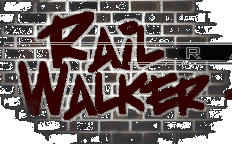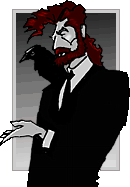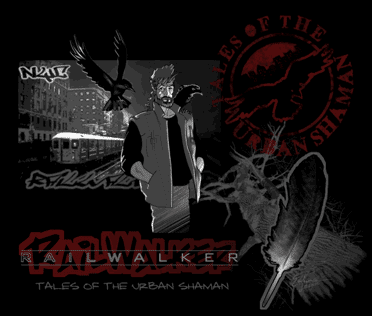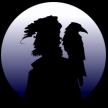 |
|
|
|
Brick, the Urban Shaman, AKA the RailWalker, began life as a supporting character in a story I was writing back in the mid-eighties. It quickly became evident, however, that Brick and his companions, the crows, had stories of their own to tell. However, although they may have had their own stories to tell, at that time, either I didn't have the skills to tell them, or the world wasn't ready for them. |
|
|
|
RailWalker at Rites was a resounding success, resulted in a second series, and then a third. A printed collection is in production now, there's a coffee mug, and a T-Shirt (both available on the Crowphenalia page). Brick and the crows are fast becoming celebrities, at least within a certain segment of the population. There are also several short stories and a number of longer ones written, some in text and some as comics scripts. There are two RailWalker graphic novels in preparation, and a proposal for an ongoing comic book series. Comics publishers who are interested should write to inquire. |
|
|
|
Back in the 1970s, when I worked for an ad agency, I got real good at writing the sort of promotional corporate-speak crap that fills advertising, brochures and resumes (and many websites) even today. When I first hooked into the web, I put up my own brochure ware website, and of course it had to include a bio/resume. In the process of writing that section, I discovered two things: first, that times had changed, and the language had changed (as language always does), and so I was no longer really good at it. Second, that I really hated doing it. So you won't find any of that here. You want to know about my art and career, you can go to my website, Eagleson Design, and see my portfolio, or visit Shapeshifter Masks, which showcases my hand sculpted leather masks. On the other hand, if you want to know about who Duncan Eagleson is, what you'll find on this RailWalker site can tell you more about who I am than any list of my previous clients (and my accomplishments for them) ever could. In fact, I generally feel that all anybody really needs to know about me is there in RailWalker and my other works. For the terminally curious, an assortment of gratuitous personal detail: I used to fence and perform stage combat (little time for that these days), I collect antique swords, Egyptian statuary, and animal skulls, and I've been known to play drums from time to time (mostly middle eastern frame drum and doumbek). Before turning to art full time, along the way I made a living as an astrologer and cartomancer, a bank teller, a musical instrument salesman (I sold one of the very first commercial Moog synthesizers) and a private investigator (by far my least favorite job). I once had a valet named Stan who used to smile a lot. These days he helps me out in the mask studio. And, yes, I do often talk to crows. Duncan |
|
Q: When's the book coming out? A: When I get to it. Converting a series designed for the web to a print format is not a simple task, any more than going the other way. Took me more than three years to get around to converting the original Brick story, A Good Night to Die to html. It will happen eventually, but don't be holding your breath. Q: What's with the name, "RailWalker"? What's that mean?? A: What do you think it means? It's one of the many names Brick's real-life counterpart was tagged with, and I liked it enough to use it as a title. Seems to me to imply a whole raft of meanings; his walking the rails of the subway as a graffiti artist, his walking the line between life and death, between this world and the next, between sanity and madness, between the world of the Crows and the world of human beings. That's a start, anyway. There's more to it than that, but you can work the rest out for yourself. In fact, I think it would be not only presumptuous, but foolish, for me to try to be definitive about what "RailWalker" means precisely. If it's any good as a poetic allusion, it will have all sorts of resonances for all sorts of people, possibly some for you that it doesn't have for me, and vice versa. Q: So Brick really exists? A: In a sense. yes. The character is based on someone I know. But the Brick of RailWalker is no more the real person I based him on than Sherlock Holmes was really Dr. Joseph Bell (One of Conan Doyle's teachers at Edinburgh College). The real-life individual is no more than a jumping-off point for the creation of a fictional character. Q: I thought maybe Brick was really a version of Duncan? A: That too. Look, any artist or writer puts a certain amount of themselves into any character they create. It would be foolish to deny that Brick sometimes speaks for me. But he also speaks sometimes for his real-life counterpart, and sometimes for himself and no-one else. Any writer will tell you that once you start writing, characters have a tendency to develop their own personalities and agendas, quite independent of their creator's conscious intentions. That's certainly true of Brick. Q: What's with the whole Graffiti thing anyway? A: Years ago, when I lived in New York City, I wrote graffiti (tho what we did was a form of art, we referred to ourselves as graffiti writers, not graffiti artists), and so did the original model for Brick. The Brick of the stories naturally followed suit - he was a writer in his younger years, and tho he doesn't put up much these days, eventually you will see some of the stories from his earlier life, when he was more active tagging and putting up. And by the way, don't bother to write to me if you're going to rant at me about graffiti being vandalism. Sure, some guys tag for spite and to destroy, but the serious writers are true artists, and creators, not destroyers. Get over it. Q: What are crows doing in the city? I thought they were country birds? A: If you have to ask that question, either you've never spent much time in a city, or you weren't paying much attention when you did. Cities in the U.S. - and New York City in particular - are full of crows. They don't get as much notice as pigeons, perhaps, but they're definitely there. Q: But crows don't really talk... A: Wanna bet? Crows are some of the most intelligent creatures around. A crow's brain is larger for it's size than any of the other winged dinosaurs we call "birds". Unlike most avian creatures (who tend to be a pretty brainless bunch), they can count, they have a sense of humor, and they even have the ability to grasp certain abstract concepts. Crows have complex social systems - they take care of their elder members, as well as the young, and they even conduct what appear to be funeral ceremonies for their dead. They're survivors, tough and feisty... what other animal is going to play pranks on a wolf, pecking at it's tail, or dropping acorns on it's head? Try talking to a crow sometime - almost guaranteed, they'll talk back. If you don't understand what they're saying, that's not my problem. Q: How do you do the art? A: Partly by hand, partly digitally. Most of the drawings are done by hand, scanned, and then tweaked and polished on the computer. They're colored on the computer, and digital typesetting & vector balloons are added. The work is done in CorelDraw, Corel Photopaint, Adobe Photoshop, and occasionally Macromedia Flash. Q: Will there eventually be another "RailWalker at Rites" series? A: Maybe. |
| HOME CROWPHENALIA ORACLE FANS ABOUT LINKS |

 I wrote and pencilled one five page story,
I wrote and pencilled one five page story,  So A Good Night to Die was privately printed, circulated among friends, and the rest of the Brick stories remained notes and sketches in my files until the
So A Good Night to Die was privately printed, circulated among friends, and the rest of the Brick stories remained notes and sketches in my files until the 

